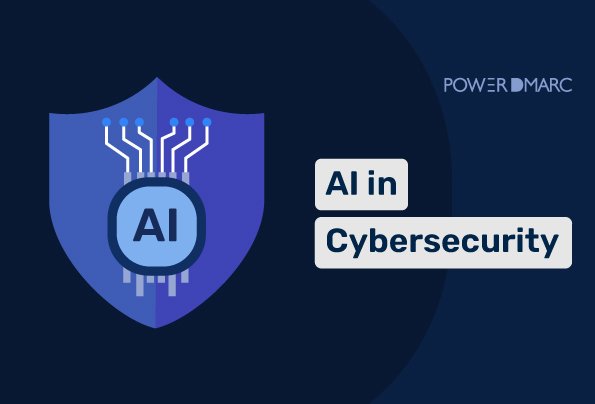The enterprise attack surface is enormous, and it’s just getting more significant. To quantify risk, up to several hundred billion time-varying signals effectively must be processed. The amount of signals depends on the size of the company. As a result, it is no longer a human-scale task to analyze and improve cybersecurity posture. Cybersecurity is a constantly evolving field, and the latest technology is constantly being incorporated into the fight to keep your data safe. This is why we need AI in Cybersecurity.
To combat this unprecedented challenge, PowerDMARC uses AI-based email security and DMARC solutions to assist information security teams. We reduce the breach risk and improve the security posture of emails more efficiently and effectively.
In recent years, artificial intelligence (AI) has become a crucial tool for strengthening the work of human information security teams. AI provides much-needed analysis and threat identification that cybersecurity professionals can utilize to decrease breach risk and improve security posture because humans can no longer adequately protect the dynamic corporate attack surface. In security, AI can identify and prioritize risk, detect malware on a network quickly, lead incident response, and detect intrusions before they occur. However, attackers also leverage technologies like machine learning; for instance, machine learning-based email fraud uses algorithms trained on large datasets to generate convincing phishing emails that mimic legitimate communication styles, aiming to trick recipients into revealing sensitive information. Staying ahead requires a multi-layered defense.
Key Takeaways
- The increasing complexity and attacker use of AI/ML necessitate advanced AI integration in cybersecurity for robust defense.
- AI enhances threat detection through automation, anomaly recognition, and predictive analytics for faster, proactive responses.
- AI-driven tools, like PowerDMARC’s Threat Intelligence and automated platform, streamline security protocol implementation (e.g., DMARC) and management.
- Effective cybersecurity combines AI technology with human expertise, crucial user education on recognizing threats like phishing, and security practices like multi-factor authentication (MFA).
- Continuous monitoring, staying informed about evolving cyber threats, and leveraging AI for analysis are vital for maintaining a strong security posture.
Role of AI in Cybersecurity
An artificial intelligence (AI) systems like AI voice generators and text-to-speech advancements, enable machines to perform tasks that usually require human intelligence, such as visual perception, speech recognition, decision-making, and translation between languages. Machine learning, a subset of AI, allows computers to learn from examples and make predictions; cybercriminals exploit this by programming bots to analyze legitimate emails, learning to mimic signatures, subject lines, and response styles to make fraudulent messages seem authentic.
The applications of AI in cybersecurity include:
- Intrusion detection: AI can detect network attacks, malware infections, and other cyber threats.
- Cyber analytics: AI is also used for analyzing big data to detect patterns and anomalies in an organization’s cybersecurity posture.
- Secure software development: AI-powered security tools can analyze code for vulnerabilities that could be exploited through email attacks.
According to software development company Simpalm, “AI can help create more secure software by providing developers with real-time feedback on whether their code is closed or not.”
Cybersecurity professionals have been using AI-based solutions for some time now. However, due to the growing number of cyberattacks, they see the need for more advanced AI tools and technologies to keep up with the attacks. The best way to stay ahead of evolving threats like machine learning-based email fraud is by staying on top of emerging trends in cyber security and adopting a multi-layered defense strategy.
Simplify Cybersecurity with PowerDMARC!
The Future of AI in Cybersecurity
Artificial intelligence can change everything about how we live and work, including how we protect ourselves from cyber threats. It will enable us to understand risk more accurately than ever before and make decisions quickly without compromising accuracy. By leveraging generative AI consulting, organizations can design custom security models that align with their unique threat landscape and accelerate the adoption of AI-driven defenses.
It will allow us to detect new attacks faster than ever before. Also, it determines how best to protect ourselves against them without waiting for humans to intervene. In some other cases, like writing and generating content (e.g., a technical whitepaper or a Juno film analysis essay), you can also use an AI detector to see whether the content is completely auto-generated or not. Integrating AI detectors into content assessment processes can also enhance overall quality control measures, ensuring that content meets standards of originality and relevance.
If your content is flagged as AI-written, the best approach is to humanize it so that it sounds not only natural but also authentic. You can humanize the text manually or use an AI text humanizer tool.
How AI can Help Protect Against Cyberattacks?
AI can’t replace humans, but it does have a role to play in the fight against cyberattacks. A multi-layered approach combining AI with human expertise and user education is key. Here’s how AI is helping protect against the next cyberattack:
1. Automated Threat Detection
The first way AI can help protect against cyberattacks is by automating threat detection. Machine learning algorithms detect user behaviour or system performance anomalies that may indicate a security breach. Advanced email security solutions also use machine learning to analyze email data and detect anomalies indicative of fraudulent activity, complementing standard protocols like SPF, DKIM, and DMARC which authenticate senders and verify message integrity.
2. Machine Learning
It uses algorithms to analyze large amounts of data and make predictions based on patterns it finds in the data. This is used to train AI systems to recognize previously unknown or unexpected attacks. It can also use behavioral analysis to identify unusual patterns of activity that may indicate a phishing attack.
3. Predictive Analytics
You can forecast future threats using predictive analytics, such as which employee accounts are most likely to become compromised or what types of attacks are likely to occur on a specific day. This type of analysis helps organizations identify where their security gaps lie to close them before any real damage is done.
4. Anomaly Detection
AI systems also can detect anomalies in network traffic or other data streams by analyzing patterns for similarities or differences between what is expected and what occurs. This type of monitoring can help catch abnormal behaviour before it becomes malicious activity — like someone trying to access confidential information that they shouldn’t. It is also important to monitor system logs and user activity for suspicious behavior that may indicate a cybersecurity threat.
5. Security Automation
AI in business can enhance cybersecurity by automating and enforcing new security policies and protocols to protect against cyberattacks. It protects against major cyberattacks like Spoofing threats, phishing, and others. Automating your cybersecurity implementation can help you:
- Save time and effort
- Reduce human-error
- Provide cost-effective solutions with 100% accuracy
- Provide immediately noticeable results
6. Security Orchestration
AI can automate many routine tasks that consume time and resources today, such as detecting abnormal behaviour or identifying suspicious users on your network.
7. Enhancing Human Capabilities
While AI handles large-scale data analysis and automation, human expertise remains crucial. Many organizations also bring in AI consultants to help bridge the gap – offering guidance on how to integrate AI tools effectively and align them with internal security policies. Alongside this, user education is a critical component; employees must be trained to recognize phishing attempts, avoid clicking suspicious links or downloading attachments from unknown sources, and report potential threats.
Furthermore, implementing multi-factor authentication (MFA) adds a vital security layer, requiring multiple forms of verification (like passwords, security tokens, or biometrics) before granting access to sensitive systems or data. Staying up to date with the latest cybersecurity trends through industry publications and threat intelligence reports is also essential.
Take your Email Authentication to the next level with AI-Driven DMARC Solutions
Your network becomes easier to manage with true AI. While minimizing errors, you may swiftly configure, troubleshoot, and defend your network. And you’re providing a next-level experience when you can repair problems before they affect people.
DMARC Threat Intelligence
The DMARC Threat Intelligence (TI) engine from PowerDMARC helps you set up your protocols swiftly while also identifying potential risks. By monitoring, identifying, and analyzing harmful activities at every step of your email’s journey. The DMARC Threat Intelligence (TI) engine provides enterprises with actionable, timely, and relevant insight.
AI-driven record generator and lookup tools
PowerToolbox contains AI-driven DNS record generator and lookup tools that provide instant results. If you want to start your authentication journey but don’t know where to start, these beginner-friendly tools use artificial intelligence to help you create SPF, DKIM and DMARC records with a click of a button! If you already have protocols set up, you can cross-check the validity of your records using lookup tools.
An automated platform powered by AI
The PowerDMARC platform (DMARC report analyzer dashboard) is fully automated, with the capacity to track IP geolocations, organizations, and email sending sources across a single AI-driven interface, parsing DMARC reports in real-time and arranging data into an organized format.
To safeguard organizations from potential spoofing attacks, phishing attacks and other forms of email fraud, this platform helps you view your DMARC data to hunt down suspicious IPs and take actionable steps against them.
Conclusion
Cybersecurity is a complex issue, but AI can be a powerful tool in helping to protect against attacks, especially sophisticated threats like machine learning-based email fraud. AI enables cybersecurity teams to establish powerful human-machine collaborations that expand our knowledge, enrich our lives, and drive cybersecurity in ways that appear to be larger than the sum of their parts. However, technology alone is not sufficient. Staying ahead requires a multi-layered approach combining advanced AI solutions with human expertise, robust security practices like MFA, continuous monitoring, and critically, user education to recognize and respond to evolving threats.
With trustworthy partners, you can stay ahead of threats and gain real-time intelligence and security.
The patented DMARC Threat Intelligence (TI) engine from PowerDMARC is your sentry on a 24-hour watch. Their AI-based threat detection solution employs sophisticated algorithms to quickly identify the global blocklists where each IP is listed and the email reputation of the sender hostname. All of this is done at a level of precision that a person could never achieve.
Grab your free DMARC trial now!

- Suped Alternatives: Top DMARC Management Platforms in 2026 - December 25, 2025
- What Is a PTR Record and Why It Matters - December 24, 2025
- SPF, DKIM, DMARC: What They Are and Why They Matter - December 23, 2025



